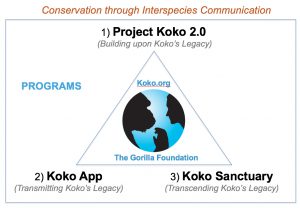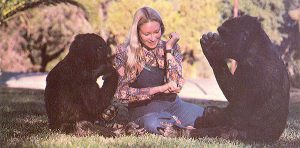Mission
Conservation through Communication: to learn about gorillas by communicating with them, and apply the knowledge and empathy thus gained to advance great ape conservation and optimize their care in captivity.
The Gorilla Foundation is best known through its unique and groundbreaking 5-decade interspecies communication study — Project Koko — which involved teaching American Sign language (ASL) to 2 lowland gorillas: Koko and Michael.
Meet Koko
Meet the Gorilla Foundation and Project Koko
Project Koko is the longest running interspecies communication in history and the only one involving gorillas. It has been the core program and strategy that has enabled the Gorilla Foundation to gain extraordinary leverage on the above mission.
Strategic Plan
By applying our core strength — interspecies communication-based research and care — we can provide an urgently needed service to great apes worldwide, both in captivity and in the wild, while inspiring our children to get involved. Our approach is 3-fold, as illustrated in the following diagram:

1) Project Koko 2.0
Build on 46 years of interspecies communication research data and experience, and continue our vital dialogue with gorillas (initiated with Koko and Michael) in order to improve their lives in captivity, save them from extinction in the wild. Focus on the well-being & understanding of the gorilla family; Ndume’s family. Collaborate and train researchers, conservationists & the public.
2) The Koko App
Transmit Koko’s sign language abilities (which are by nature available to all gorillas) to other captive gorillas in both zoos and sanctuaries, by making it easy for everyone to learn basic sign language directly from Koko. Develop a simple video-based phone app that can be used by people around the world, and equipped with special tutorials for great ape care, conservation and social-emotional learning.
3) The KokoMaui Sanctuary
Establish the first gorilla sanctuary outside of Africa—on the island of Maui (ideal climate/loc.)—in partnership with a gorilla facility that shares The Gorilla Foundation’s vision of conservation through communication, empathy and creating an environment as close to the gorillas’ native habitat as possible. Make the sanctuary a model for “free-living-like” captive care with optional human interaction and remote video viewing and learning opportunities for the public.
Values
The Gorilla Foundation’s core values guide how we implement the above strategy, and how we interact with others on whom we rely to help us achieve the mission. Our most basic values may be summarized as follows:
1) Gorillas’ Needs First:Ensure that the physical, social, and emotional needs of the gorillas in our care are met.
2) Research-Based:All of our programs, including Communication, Conservation, Education, and Care, are research-based, including naturalistic observation and experimental methods where possible.
3) Holistic Approach: Always consider interspecies interactions in a holistic socio-cultural, mind-body context, employing integrative methods, and least-invasive remedies first.
4) Apply the Knowledge where Needed Most:Prioritize interspecies communication research projects based upon the anticipated potential benefits for great ape conservation, education, and care and wellness.
5) Long-Term Commitment: Recognize the value of research that extends over significant portions of the lifetime of the subjects, and respect the emotional bonds and obligations that develop during such long-term interspecies relationships.
6) Service to All Great Ape Species:Our interests and concerns are not limited to gorillas, but include all of the great ape species: chimpanzees, bonobos, orangutans and humans, who have much in common, and much to offer and learn from one another.
7) Strive to Enlighten:Some of the discoveries we have made about gorilla intelligence have the potential to change human awareness about our interconnectedness and interdependence wth other beings. We believe such attitudinal shifts are essential and can enable more rapid solutions to great ape conservation and captive care management problems.


